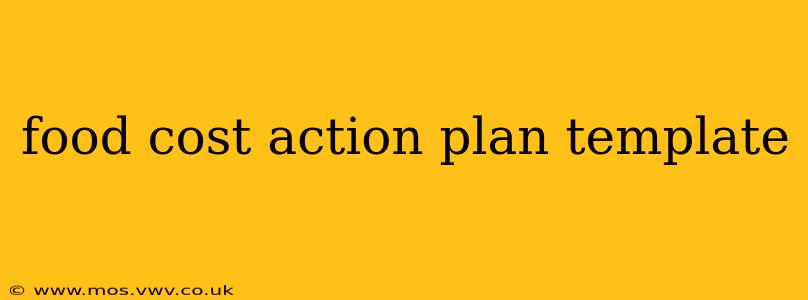Controlling food costs is crucial for the success of any food service operation, whether it's a bustling restaurant, a thriving catering business, or a bustling cafe. This food cost action plan template provides a structured approach to identifying areas for improvement and implementing effective strategies to reduce expenses without compromising quality or customer satisfaction.
Understanding Your Current Food Cost Percentage
Before diving into solutions, you need a clear picture of your current situation. Calculate your food cost percentage using this formula:
(Beginning Inventory + Purchases - Ending Inventory) / Total Food Revenue = Food Cost Percentage
Aim for an industry-standard food cost percentage, which varies depending on your type of establishment. Research benchmarks for similar businesses in your area. A high food cost percentage signals a need for immediate action.
Identifying Areas for Improvement: A Comprehensive Analysis
This section forms the core of your food cost action plan. Thoroughly analyze each aspect of your operations to pinpoint areas where costs can be reduced.
1. Inventory Management: Minimizing Waste and Spoilage
- Regular Inventory Counts: Implement a consistent inventory tracking system. Regular physical counts, ideally weekly, help identify slow-moving items and potential spoilage.
- FIFO (First-In, First-Out): Strictly adhere to the FIFO method to ensure older products are used before newer ones, minimizing spoilage.
- Proper Storage: Invest in proper storage equipment (refrigerators, freezers) and maintain optimal temperatures to extend the shelf life of ingredients.
- Portion Control: Implement precise portion control measures to avoid over-serving and reduce waste. Use standardized recipes and portioning tools.
2. Recipe Standardization and Costing: Optimizing Recipes
- Standardize Recipes: Create detailed, standardized recipes for every dish. This ensures consistency and prevents excessive ingredient usage.
- Recipe Costing: Accurately cost each recipe to determine its profitability. Identify high-cost ingredients and explore alternatives without sacrificing quality.
- Menu Engineering: Analyze your menu's profitability. Identify high-profit, low-cost items and promote them. Consider removing low-profit, high-cost items.
3. Purchasing and Supplier Relationships: Negotiating Better Deals
- Negotiate with Suppliers: Develop strong relationships with suppliers and negotiate better pricing, especially for high-volume ingredients.
- Explore Alternative Suppliers: Compare prices from multiple suppliers to find the best deals.
- Bulk Purchasing: Consider purchasing ingredients in bulk to obtain lower unit costs, but only if you have adequate storage and can use the ingredients before they spoil.
- Seasonal Ingredients: Utilize seasonal ingredients whenever possible. They're often cheaper and fresher.
4. Staff Training and Efficiency: Minimizing Errors and Waste
- Proper Training: Train your staff thoroughly on proper handling, storage, and preparation techniques to minimize waste and spoilage.
- Inventory Tracking Training: Ensure your staff understands how to accurately track inventory and report discrepancies.
- Portion Control Training: Train staff on proper portioning techniques to maintain consistency and avoid over-serving.
5. Waste Reduction Strategies: Reducing Spoilage and Leftovers
- Employee Meal Programs: Implement a structured employee meal program to utilize leftover ingredients.
- Creative Menu Planning: Design menus that minimize waste by using the same ingredients in multiple dishes.
- Composting: If feasible, implement a composting system to reduce food waste and utilize organic waste for gardening or other purposes.
Monitoring and Evaluation: Tracking Progress and Making Adjustments
- Regular Reporting: Monitor your food cost percentage regularly (weekly or monthly) to track your progress.
- Data Analysis: Analyze your data to identify trends and areas that still need improvement.
- Actionable Adjustments: Based on your analysis, make necessary adjustments to your strategies and processes. This is an ongoing process; continuous improvement is key.
Conclusion: A Sustainable Approach to Food Cost Control
Implementing this food cost action plan requires commitment and consistent effort. By proactively addressing inventory management, recipe optimization, purchasing strategies, staff training, and waste reduction, you can significantly lower your food costs, enhance profitability, and ensure the long-term success of your food service operation. Remember that this is a continuous process; regular monitoring and adjustments are vital for maintaining optimal food cost control.
